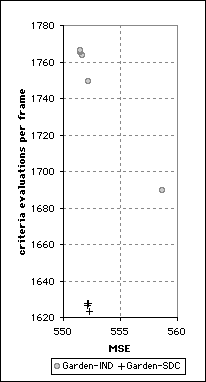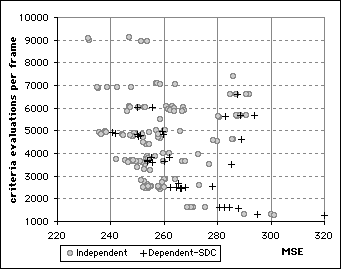next >
Spatial Dependency (Type C) Results
Type C spatial redundancy was more restrictive than type A. It exploited spatial redundancy only when the blocks above and to the left of the target had identical motion vectors. In such cases the algorithms began their searches at the position corresponding to these vectors. Otherwise the algorithms behaved normally and began their searches at the centre of the search area.
Spatial dependency of Type C was more successful than Type A. More importantly, however, although this spatial redundancy failed to improve the performance of some algorithms, it did not significantly deteriorate the performance of any.


Performance of Independent and Spatially Dependent OTS when coding the Football (above left) and Garden (above right) sequences.
Spatial Dependency C improved the performance of the OTS on the Garden and Football sequence, but adversely affected the performance on the OTS when coding the Tennis sequence.
As can be seen from the graph below, the data for the spatially dependent algorithms approach the cost-quality curve of the independent algorithms. On only a few occasions did the dependent algorithms outperform the independent ones. The dependent algorithms at an MSE of about 420 that appear to have outperformed the independent algorithms are Greedy Algorithms C and F. The dependent data points beginning at an MSE of 450 are the result of the dependent OTS. Clearly, however, the spatial dependency did not significantly improve the performance of the algorithms.

Performance of Independent and Spatially Dependent (Type C) algorithms during coding of Football sequence.
Spatial dependency (Type C) proved to be of assistance when coding the Garden sequence. Spatial dependent variations of Greedy Algorithms C and F generated images with competitive cost-quality performance. This can be seen from this graph:
Performance of Independent and Spatially Dependent (Type C) algorithms used to code the Garden sequence.
Spatial Dependency of this type did not assist the algorithms coding the Tennis sequence. Unlike the Type A spatial dependency, however, Type C did not cause the algorithms to perform disastrously.
Thus spatial dependency type C failed to improve the performance of the algorithms. The concurring neighbours restriction (the difference between types A and C) improved the performance of the algorithms and it is likely that other dependent algorithms might also benefit from this modification.
Performance of Spatially Dependent (Type C) algorithms compared to independent algorithms used to code the Tennis sequence.
© Colin E. Manning 1996






